Chapter 3 Diversity In Living Organisms
Biodiversity is defined as the variety and variability of living organisms on earth. It is a measure of the diversity of living organisms found in various ecosystems. Terrestrial biodiversity is more near the equator, due to its warm climate and increased primary productivity.
Biodiversity is not distributed evenly on the planet. Tropics have the richest biodiversity. For aquatic biodiversity, marine biodiversity is the highest along sea coasts in Western Pacific, where the temperature of the sea surface is highest. Biodiversity is generally concentrated in groups in specific hotspots.
Biodiversity refers to the number and variety of living organisms existing on earth. It is an important component of nature, which ensures the survival of human beings by providing food, fuel, shelter, medicines and other resources.
The richness of biodiversity is dependent on the climatic conditions of that region. All species of plants taken together are called flora. All species of animals taken together are called fauna.
Read and Learn More: NEET Foundation Notes
Raymond F. Dasmann (1968) first of all used the term biological diversity in his book ‘A Different Kind of Country’. During 1980’s, this term came into common usage in science and environmental policy. Thomas Lovejoy introduced the term to the scientific community.
The contracted term ‘biodiversity’ was coined by W. G. Rosen (1985) during the planning of National Forum on Biological Diversity organized by the National Research Council (NRC). It first reflected in a publication in 1988 when E. O. Wilson made it the title of the proceedings of that forum.
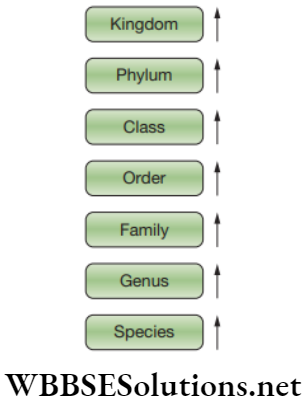
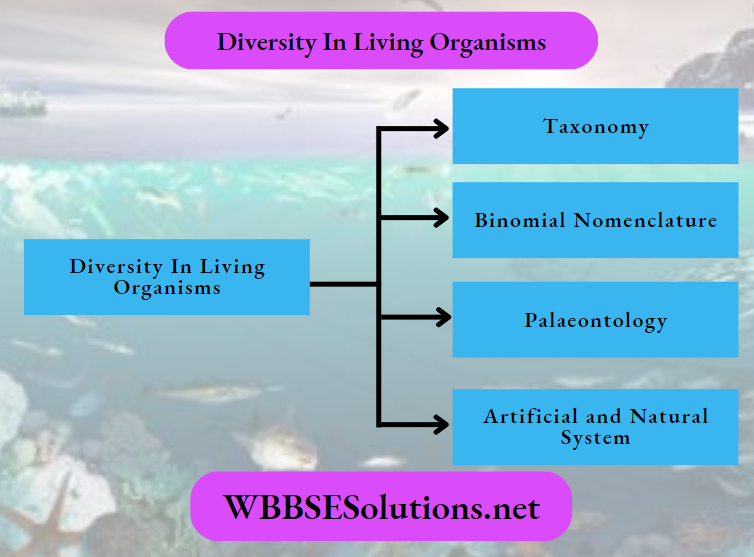
Chapter 3 Diversity In Living Organisms Basis of Classification
Taxonomy is the scientific study of identification, nomenclature and classification of organisms. A consistent international system of naming is very important because common vernacular names for the same plant or animal vary from one region to another, but a single scientific name is followed across the world.
Binomial Nomenclature
It is the naming system where every organism’s scientific names consist of two names, where the first name is the genus to which an organism belongs and the second name is the species to which it belongs. The species is specific to a specific organism and the name is not shared with any other organism in that particular genus.
Guidelines for ICBN
The scientific names are guided by a set ofrules in the International Code of Biological Nomenclature (ICBN). According to this, the genus name or generic name should be written first with its first letter capitalized. Species name or specific name should be written after the generic name and its first letter should always be in small case. The whole of the scientific name should be printed in italics and when written by hand, it should be underlined.
The scientific names are usually Latin names or possess Latin endings. Latin is a holdover from the times when scholars communicated in this tongue. A formal system of Latin nomenclature is used in order to differentiate each type of organism in language that is precise, consistent and understandable to scientific world.
The diversity displayed amongst present day organisms is a result of the past 3.5 billion years of organic evolution. At that time, a huge number of new species originated and also many more got extinct. Palaeontology is the study of evidences of the past life in the form of fossils. With such a large repository of organisms, it would not be easy to study each and every living form separately at an individual level.
Thus, to study the diversity amongst the living organisms effectively, one needs to arrange the various types of organisms in an orderly or systematic way. The method of arranging organisms into groups based on the similarities and differences is called classification.
Advantages of Classification
- Classification is the better and easier way of studying a wide variety of organisms.
- Classification provides a big picture of all life forms in one view.
- Classification helps understand the interrelationships amongst different groups of organisms.
- Classification makes the foundation for the development of other branches of biology. For example, biogeography, the study of geographical distribution of plants and animals is totally dependent on the information provided by classification of organisms.
Chapter 3 Diversity In Living Organisms Classification and Evolution
The classification of living organisms is associated with their evolution. Most of the living organisms seen today has evolved owing to the accumulation of changes in its body structure that permits the organisms possessing them to survive better. This idea of evolution was first of all described by Charles Darwin in his book ‘The Origin of Species’ published in 1839.
Evolution is defined as the change in the heritable characteristics of biological populations over successive generations. Evolution gives rise to biodiversity at all levels of biological organization, including the levels of species, genus and molecules.
If evolution is related to classification, then it is very clear that some groups or organisms with ancient body structures have not changed much. Those organisms with ancient body structure are known as primitive (lower) organisms. Those organisms with recent body structure are known as advanced (higher) organisms.
The organisms dating back to early ages (ancient, older) were simpler in structure, whereas younger organisms (later formed, modern) are more complex. Hence, the complexity in structure from being a primitive organism has increased over evolutionary time, so that they have become far more complex.
Ernst Mayer (1985), a Professor in the Harvard University, opined that Darwinism should be considered in terms of five major theories, such as perpetual change, common descent, multiplication of species, graduation and natural selection.
Diversity Of Living Organisms
- Perpetual change: This is the basic theory of evolution stating that the living world is not constant and also not perpetually cycling but it always changes. The characteristics of organisms undergo transformation throughout generations across the whole duration.
- Common descent: This theory states that all forms of life originated from a common ancestor with branching of lineages.
- Multiplication of species: This theory states that the process of evolution creates new species by the splitting and transformation of older ones.
- Graduation: This theory states that the large differences in anatomical characteristics make different species originate due to the accumulation of numerous small incremental changes over long duration of time.
- Natural selection: This theory is based on three propositions and they are as follows.
-
- There is variation amongst organisms (within populations) for anatomical, behavioural and physiological traits.
- The variation is at least partly heritable so that offspring tends to resemble their parents.
- Organisms with different variant forms leave different numbers of offspring to future generations.
Artificial and Natural System of Classification
Aristotle (384–322 BCE) and Theophrastus (372–287 BCE) followed the artificial system of classification in which they classified the living organisms based on a few arbitrarily chosen criteria, like size, colour or nature of the organisms.
Aristotle classified living organisms on the basis of their nature and divided the animals based on whether they lived on land, sea or air. Theophrastus categorized all known plants on the basis of their form, life-span and habitat. He divided plants into four categories, such as trees, shrubs, undershrubs and herbs.
In 1735, Carl von Linnaeus, published a book, Systema Naturae (Classification of Nature), in which he classified, described and named plants and animals. His classification was based on the sexual characters of living organisms, i.e., number and arrangement of stamens and carpels in the flower. But, his classification was also an artificial one.
During 19th century, the artificial system of classification was replaced by natural system of classification. This system was based on natural affinities between living organisms and it indicated the overall similarities and differences between the organisms.
Classification Systems
There are two main systems of classification of living organisms, such as two-kingdom system of classification and five-kingdom system of classification.
- Two-kingdom system of classification: This system of classification was first proposed by Carolus Linnaeus (1758). Living organisms are divided into two kingdoms, such as plant kingdom and animal kingdom.
- Five-kingdom system of classification: Whittaker (1959) has classified the living organisms into the following five kingdoms:
-
- Kingdom monera: Prokaryotic bacteria and blue-green algae.
- Kingdom protista: Unicellular eukaryotic organisms, such as protozoans, fungi and algae.
- Kingdom fungi: Multicellular higher fungi.
- Kingdom plantae: Multicellular green plants and advanced algae.
- Kingdom animalia: Multicellular animals.
Kingdom system of classification with their shortcomings and criteria for classification
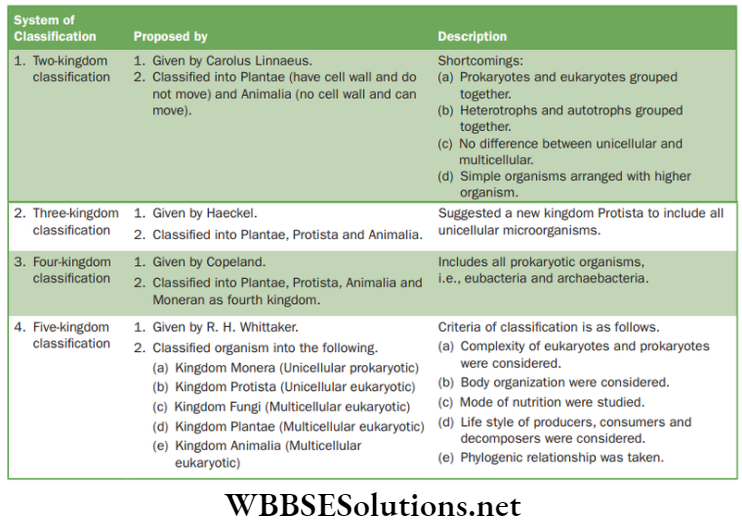
Modern scheme of five-kingdom classification: In 1982, Margulis and Schwartz revised the five-kingdom classification and included one prokaryotic kingdom and four eukaryotic kingdoms as follows.
- Kingdom Prokaryotae (prokaryotic kingdom)
- Kingdom Protocista (eukaryotic kingdom)
- Kingdom Fungi (eukaryotic kingdom)
- Kingdom Plantae (eukaryotic kingdom)
- Kingdom Animalia (eukaryotic kingdom)
| Class 11 Physics | Class 12 Maths | Class 11 Chemistry |
| NEET Foundation | Class 12 Physics | NEET Physics |
Chapter 3 Diversity In Living Organisms Hierarchy of Classification or Groups
Linnaeus proposed a framework of arranging organisms into an ascending series of groups of ever increasing inclusiveness and this is known as hierarchical system of classification. In taxonomy, the main aim is to assign organism an appropriate place within the systematic framework of classification, which is called taxonomic hierarchy, by which the taxonomic groups are arranged in a definite order from higher to lower categories.
A category\ is given the name as a taxon (plural taxa). The taxa used in the classification of plants or animals are kingdom, phylum, class, order, family, genus and species. However, in plants, the phylum is replaced by the term division. All the members of a taxon show similar characteristics that are different from those of other taxa.
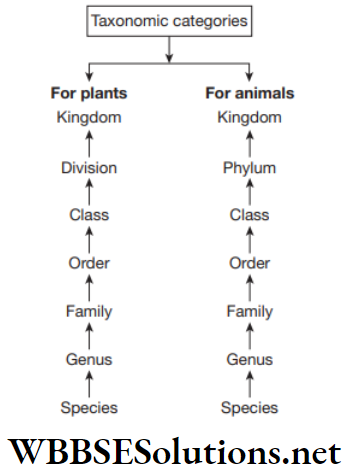
- Species: Species is a group of individuals with similar morphological characteristics that are able to breed among themselves and produce fertile offspring of their own kind. For example, horse and ass belong to the same genera (Equus) but their species is different, i.e., horse is E. cabalus and ass is E. asinus.
- Genus: Genus is a group of species that are related and have less characteristics in common as compared to species. Members of a genus possess identical reproductive organs. For example, banyan and fig trees are different from each other in their shape, size and surface of leaves, but they possess similar reproductive organs like inflorescence, flower, fruit and seed. Thus, both these plants belong to the same genus Ficus.
- Family: Family is a group of genera that are more similar to each other than with the genera of other families. For example, a cat (Felis domestica) and a lion (Panthera leo) both belongs to the ‘cat’ family Felidae. Both these animals possess similar structures such as retractive claws.
- Order: Order is an assemblage of families resembling one another in a fewcharacters. For example, a tiger(Panthera tigris) and a wolf (Cannis lupus) possess similar characteristics like jaws with powerful incisors and large, sharp canines adapted for flesh-eating. Thus, both belongs to the same order carnivora.
- Class: Class represents organisms of related orders. For example, chordates that include rats, dogs, bats, dolphins, monkeys, etc., belongs to the class Mammalia because they possess a characteristic hairy exoskeleton, mammary glands, external ear, etc.
- Phylum: Phylum includes all organisms belonging to different classes possessing some common characteristics. For example, all animals have a notochord present in the embryo and it belongs to the phylum Chordata.
- Kingdom: Kingdom includes all organisms that possess a set of distinguishing common characteristics. For example, plant kingdom, animal kingdom, etc.
Chapter 3 Diversity In Living Organisms Characteristics of Five Kingdoms
Kingdom Monera (Prokaryotes)
All the organisms of this kingdom are prokaryotes. They are unicellular organisms and possess a cell wall, whereas mycoplasmas are devoid of it. They can survive in extreme climatic conditions like hot springs and acidic soils. They show anaerobic respiration. The kingdom Monera is categorized into two sub-kingdoms, such as archaebacteria (Archaea) and eubacteria (Bacteria).
1. Archaebacteria: Archaebacteria are the most ancient forms of bacteria, for example, mycoplasma. They derive the energy for their metabolic activities from the oxidation of chemical energy sources like reduced gases, such as ammonia, methane or hydrogen sulphide.
Archaebacteria produces their own amino acids and proteins in the presence of any of these reduced gases. Archaebacteria have a specially designed tough cell wall which provides resistance and support life under extreme conditions.
2. Eubacteria: Eubacteria are true bacteria. They are seldom found in extreme environmental conditions. They include bacteria with a rigid cell wall (Fig 3.2). They can be motile (with flagellum) or non-motile (without flagellum). A flagellum has a basal body, filament and hook. The flagella help the eubacteria to move.
They are present in various shapes such as rod-like called bacilli, spheres called cocci, corkscrew-shaped called spirilla, comma-shaped called vibrio. They can be divided on the basis of their mode of nutritions as heterotrophs or autotrophs. The autotrophic forms are either photoautotrophic or chemoautotrophic.
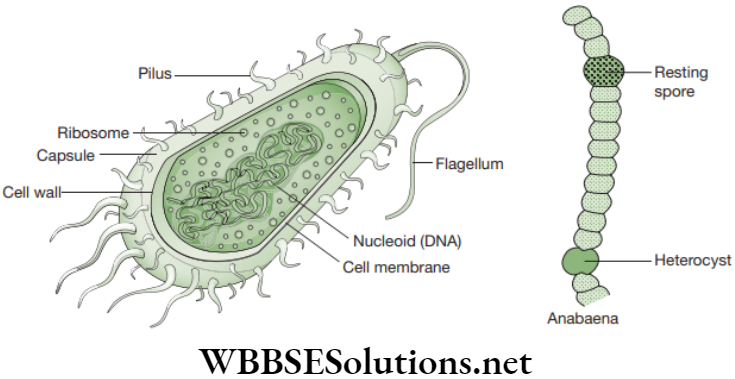
Some forms of eubacteria are motile as they possess flagella. They may be unicellular, colonial or filamentous. Cyanobacteria (blue-green algae) like Nostoc and Anabaena are filamentous in nature.
Hans Christian Gram (1884), Danish scientist, developed a method to distinguish between two kinds of bacteria on the basis of the structural differences in their cell walls. While performing this test, it was observed that some bacteria retain the crystal violet dye due to the presence of a thick layer of peptidoglycan.
These bacteria were called Gram-positive bacteria. On the other hand, Gram-negative bacteria do not retain the violet dye and are coloured red or pink.
Kingdom Protista (or Protocista)
This kingdom includes various types of unicellular eukaryotic organisms, like unicellular algae, protozoans and unicellular fungi (Oomycota and slime molds). Algae can be unicellular or multicellular. Diatoms and protozoans are unicellular. These organisms live in aquatic habitat or in moist soil.
The cells are advanced with well-defined nucleus and membrane-bound cell organelles. Some of these organisms have appendages, for example, hair-like cilia in Paramecium, whip-like flagellum in Euglena, etc.
Mode of nutrition can be autotrophic (for example, unicellular algae, diatoms) or heterotrophic (for example, protozoans), unicellular algae, chlorella, chlamydomonas, and diatoms.
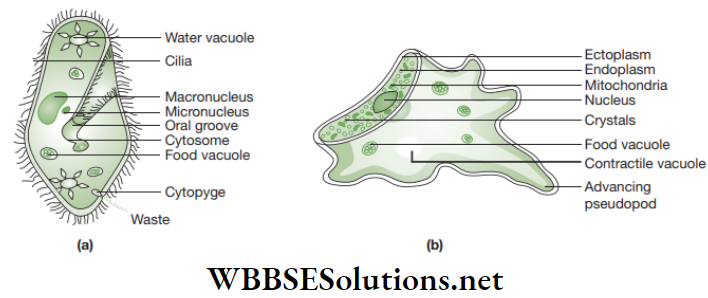
Phylum Protozoa
- Unicellular, mostly aquatic (fresh water or marine) animals.
- Solitary or colonial, free-living or parasitic or symbiotic.
- Body naked or covered by pellicle or hard shells.
- Body shape may be irregular, spherical, oval, elongated or flattened.
- Cytoplasm distinguished into outer ectoplasm and inner endoplasm.
- Uninucleate, binucleate or multinucleate.
- Locomotion using finger-like pseudopodia, flagella and cilia.
- Mode of nutrition is usually heterotrophic.
- A sexual reproduction by binary fission, multiple fission and sexual reproduction by conjugation.
Kingdom Fungi
Kingdom comprises organisms whose body is not differentiated into root, stem, and leaves. They are either unicellular and multicellular.
- Heterotrophic and eukaryotic organisms. Some fungi are parasites and some are saprophytes. Parasites derive their nutrients from the living cells of the host plants (for example, Puccinia, Albugo, Ustilago, etc.). Saprophytes derive their nutrients from the dead remains of plants and animals (for example, Mucor, Rhizopus, Penicillium, Agaricus, etc.). For example, bread mold (Rhizopus, Mucor), yeast (Saccharomyces), pink bread mold (Neurospora), green mold (Penicillium), mushroom (Agaricus), smut (Ustilago), etc.
- They may be unicellular (for example, yeast) or filamentous. The body of a multicellular and filamentous fungus is termed as a mycelium and it consists of numerous thread-like structures called hyphae.
- They have a cell wall made up of polysaccharide called chitin.
- The reserve food material is glycogen.
- Fungi derives their nutrition from dead organic matter by secreting digestive juices outside the body and then absorbing the digested food material.
- Fungi reproduces asexually by spores or by budding. They also show sexual mode of reproduction by ascospores, zygospores or basidiospores.
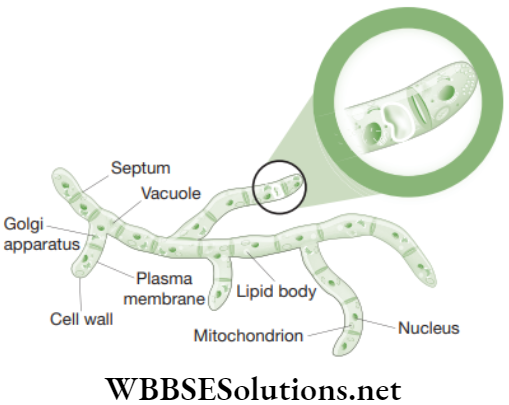
Lichens
These are association of blue-green algae and fungi living in symbiotic relationship. The algal component of the lichens is called phycobiont, whereas the fungal component is called mycobiont. The alga performs photosynthesis and provides nutrients to the fungal component, whereas the fungus absorbs water and minerals for the benefit of algal component.
Kingdom Plantae
- These are multicellular organisms except for some primitive algae.
- Cell wall consisting of cellulose occurs around the cell.
- A mature plant usually possesses a single large central vacuole bounded by a membrane called tonoplast.
- The reserve food material is starch.
- Plastids are present in all the plant cells. Some plastids possess photosynthetic pigments, i.e., chlorophylls and these plastids are called chloroplasts.
- Mode of nutrition is autotrophic.
- Growth is generally indefinite due to the presence of growing points.
- Body form is irregular due to the presence of branches.
Kingdom Animalia
- The cell wall is absent in animal cells.
- The mode of nutrition is heterotrophic.
- The growth of animals is limited and ceases after reaching maturity.
- Animals usually possess a definite shape, size, and symmetry, except for some lower forms.
- Most animals are mobile.
- Animals have organization of cellular, tissue, organs, and organ system levels.
Chapter 3 Diversity In Living Organisms Detailed Classification of Kingdom Plantae
All are eukaryotic, multicellular, and autotrophic in nature. Few are partially heterotrophic in addition, for example, insectivorous plants. Kingdom Plantae is categorized into five divisions, such as Algae, Bryophyta, Pteridophyta, Gymnospermae, and Angiospermae.
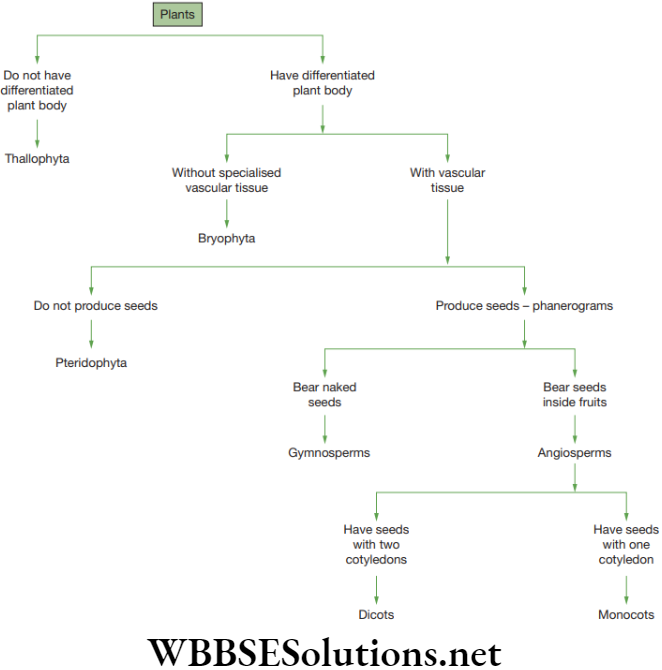
Division Algae
- Most primitive plants, in which plant body is not differentiated into root, stem and leaves. Instead it is in the form of thallus.
- Mostly aquatic forms (both freshwater and marine) and some are terrestrial.
- Supporting and conducting tissues are absent, i.e., vascular system is absent.
- Asexual reproduction occurs generally by spores.
- Sex organs are simple, single-celled and there is no embryo formation after fertilization.
- In the life cycle, the gamete-producing haploid phase called gametophytic phase is dominant. The short, spore-bearing diploid phase, the sporophytic phase, does not remain attached to the gametophyte.
- Algae can be of three main types, namely green algae (for example, Ulothrix, Spirogyra, Ulva, Chara, Cladophora), red algae (for example, Polysiphonia), brown algae (for example, Laminaria, Fucus, Sargassum).
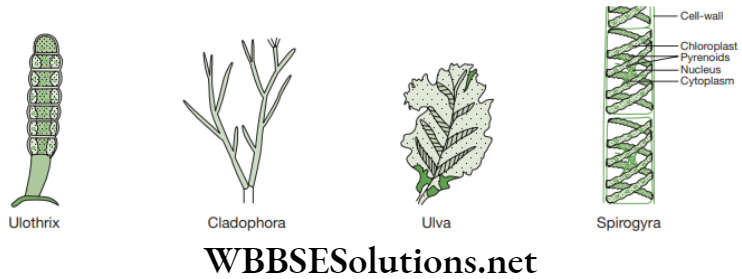
Division Bryophyta
- Small, multicellular plants that are found in the shady damp places. Hence, they are also called the amphibians of the plant kingdom.
- Plant body is a flat, green thallus in liverworts and leafy, erect structures in mosses. They lack real roots, stems and leaves.
- No true vascular system is present.
- Gametophyte is attached to a substratum by means of hairlike outgrowths called the rhizoids, which absorbs water and minerals from the substratum. Sporophyte live as a parasite over the gametophyte.
- Sex organs are multicellular.
- An embryo is formed after fertilization.
- Liverworts (Riccia, Marchantia), hornworts (Anthoceros), mosses (Funaria, Sphagnum).
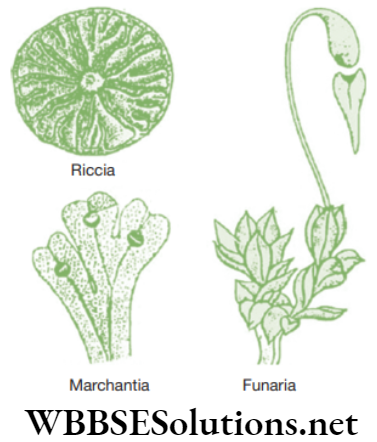
Division Pteridophyta
- They occur mainly in shady or damp places.
- The plant body is made up of root, stem and leaves.
- A well-developed vascular system for conduction of water and minerals is present.
- No flowers and no seeds.
- Sex organs are multicellular and jacketed by sterile cells.
- An embryo is formed after fertilization.
- Club mosses (Selaginella, Lycopodium), horsetails (Equisetum), ferns (Marsilea, Azolla, Adiantum, Dryopteris, Pteris, Pteridium).
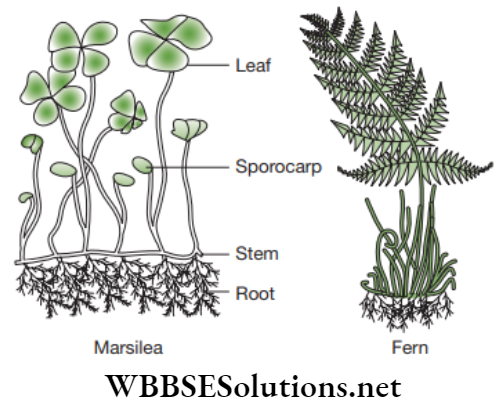
Division Gymnospermae
- Simple seed plants.
- Seeds are naked, i.e., not enclosed within fruits.
- Generally, perennial, evergreen and woody plants.
- Sporophylls are aggregated to form cones. These cones are distinguished into male and female cones.
- Xylem lacks vessels and phloem lacks companion cells.
- Gymnospermae is categorized into the following two groups.
-
- Cycadae (for example, Cycas).
- Coniferae (for example, Pinus, Cedrus, Ginkgo).
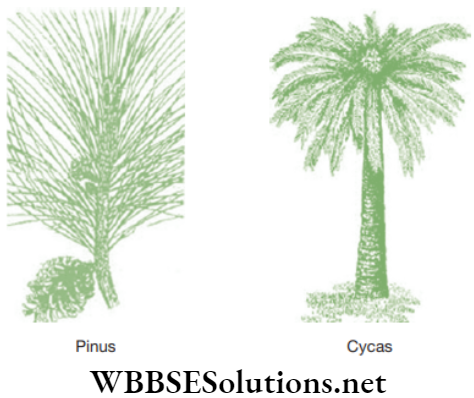
Division Angiospermae
- Highly evolved plants.
- They produce seeds enclosed within the fruit.
- Reproductive organs (sporophylls) are aggregated in a flower. Hence, they are called flowering plants.
- Plant embryos in seeds possess structures known as cotyledons. Cotyledons are known as ’seed leaves’ as in many plants they emerge and become green when the seed germinates.
- Endosperm supplies nutrients for the developing embryo in the seed. It consists of triploid cells.
Angiosperms can be divided into two types based on the number of cotyledons, such as dicotyledons and monocotyledons.
Dicotyledonae (Dicots)
- Seeds produced by these plants have embryos with two fleshy leaves, the cotyledons.
- Leaves show reticulate venation with a network of veins.
- Tap root system is present.
- Flowers have five or multiple of five petals.
- Vascular bundles are arranged in a ring.
- Vascular bundles are open (i.e., cambium) and undergo secondary growth.
- Pisum sativum (Pea), Solanum tuberosum (Potato), Helianthus annuus (Sunflower), Rosa indica (Rose), Ficus religiosa (Banyan), etc.
Monocotyledonae (Monocots)
- Seeds have one cotyledons.
- Leaves have parallel venation.
- Fibrous root system is present.
- Flowers are trimerous, i.e., have three or multiple of three petals.
- Vascular bundles are scattered and closed (i.e., lack cambium). Secondary growth does not happen.
- Zea mays(Maize), Triticum aestivum (Wheat), Oryza sativa (Rice), Allium cepa (Onion), Saccharum officinarum (Sugarcane), etc.
Chapter 3 Diversity In Living Organisms Detailed Classification of Kingdom Animalia
Kingdom Animalia is classified into sub-divisions which is also known as phyla. Each phylum shares particular structural and functional properties which together separate it from other phyla. Some of the main phyla of Kingdom Animalia are follows.
Phylum 1: Porifera
- Sessile, sedentary and marine except one group that lives in fresh water. They are popularly known as sponges.
- Simplest multicellular, diploblastic animals.
- Body design involves minimal differentiation into tissues. The cells are loosely held together in a gelatinous matrix, mesoglea and do not form tissues.
- Asymmetrical or radially symmetrical.
- The canal system is a filter-feeding system of sponges. It helps in circulating water across the body to transport food, oxygen and water.
- Mouth, digestive cavity and anus are absent.
- Skeleton is made up of small calcareous or silicious spicules or spongin fibre (collagen) or both.
- Reproduction is both asexual by budding and gemmules and sexual through fertilization. They have great power of regeneration.
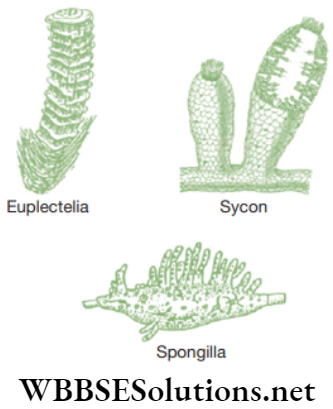
Phylum 2: Cnidaria or Coelenterata
- Mostly marine, but few fresh water living forms.
- Multicellular, diploblastic animals with tissue grade of organization. A gelatinous layer known as mesoglea persists between the ectoderm (epidermis) and endoderm (gastrodermis).
- Body shows radial symmetry.
- A central gastrovascular cavity coelenteron is present that lacks anus but has a mouth, which is surrounded with short and slender tentacles.
- Have specialized sting cells (cnidoblasts) possessing stinging cell organelles known as nematocysts. Nematocysts play a role of paralysing the prey by injecting poison or holding the prey.
- No respiratory, circulatory and excretory organs.
- Nervous system is primitive and it consists of network of nerve cells only.
- Shows the phenomenon of polymorphism. This is the specialization of individuals of colonial species for the division of labour. For instance, hydrozoans possess feeding individuals or zooids, the gastrozooids, protective zooids, the dactylozooids and reproductive zooids, the gonozooids producing sexual medusae.
- Body exhibits two main forms, the polyps and the medusa. The polyp is diploid, cylindrical and sedentary. It reproduces asexually. The medusa is diploid, umbrella-like and free-swimming sexual phase of the animal.
- Asexual reproduction takes place by budding and sexual reproduction by gametes formed by medusae.
- Many forms have a hard exoskeleton of lime to form corals.
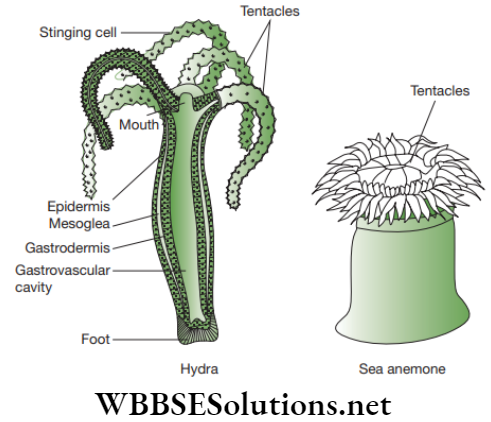
Phylum 3: Ctenophora
- Body is transparent with bilateral symmetry.
- Triploblastic.
- Locomotory organs consist of two tentacles and eight longitudinal rows of ciliary comb plates.
- Marine, solitary and free-swimming.
- Polymorphism or dimorphism is absent.
For example, Pleurobrachia (Comb jelly), Ctenoplana, Cestum (Venus’s girdle).
Phylum 4: Platyhelminthes
- Body is bilaterally symmetrical and dorsoventrally flattened.
- Body is thin, soft, leaf-like or ribbon-like for example Planaria, Liverfluxe, and Tapeworm.
- Triploblastic, i.e., their tissues differentiate from three embryonic germ layers.
- Acoelomate, i.e., no body cavity.
- Digestive cavity, if present, has a single opening called the mouth. Anus is absent.
- Suckers and hooks are generally present.
- Circulatory and respiratory systems and skeleton are absent.
- Excretory system possesses blind tubules known as protonephridia. Blind end of a tubule bears a tuft of cilia or flagellum and is known as a flame bulb or flame cell.
- Hermaphrodite.
- Turbellarians are free-living, aquatic, both marine and freshwater and some are terrestrial. Trematodes and cestodes are parasitic.
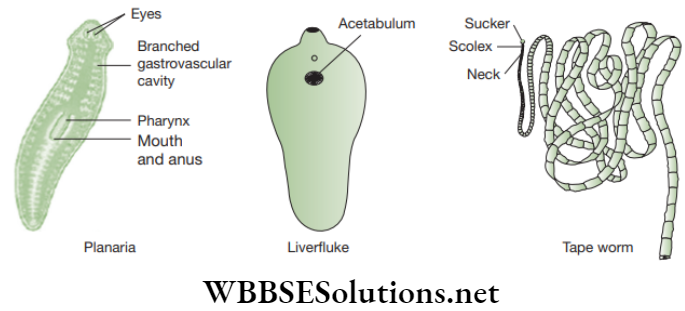
Phylum 5: Nematoda
- Body is bilaterally symmetrical, triploblastic, pseudocoelomate and unsegmented.
- Body is worm-like, cylindrical or flattened.
- Body is covered with a tough, resistant cuticle.
- Cilia is absent.
- Alimentary canal is straight and complete with mouth and anus, pharynx is muscular.
- Sexes are separate.
- Parasitic nematodes are pathogenic. For example, Wuchereria bancrofti causes elephantiasis in humans.
Example: Ascaris (Round worm), Ancylostoma (Hook worm), Wuchereria bancrofti (Filarial worm), Enterobius (Pinworm).
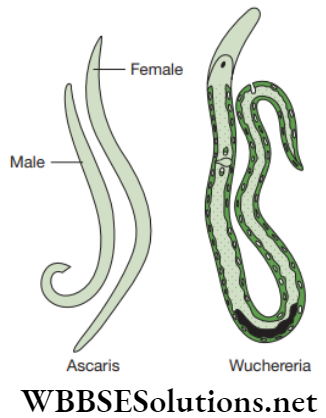
Phylum 6: Annelida
- Body is triploblastic, bilaterally symmetrical, soft, elongated, vermiform and cylindrical or dorsoventrally flattened.
- Body is metamerically segmented externally by transverse grooves and internally by septa. Some of the anterior body segments concentrate to form head.
- Exoskeleton is absent. Body is covered with a thin cuticle.
- Locomotory organs are segmentally arranged paired lateral appendages, parapodia or chitinous setae.
- Alimentary canal is complete, which extends from mouth to anus.
- True coelomate animals with closed blood vascular system.
- Excretion takes place by paired segmental nephridia that removes wastes from coelom and blood stream directly to the exterior.
- Nervous system consists of a dorsal brain and a ventral nerve cord with ganglia and lateral nerves in each body segment.
- Hermaphrodite or sexes may be separate.
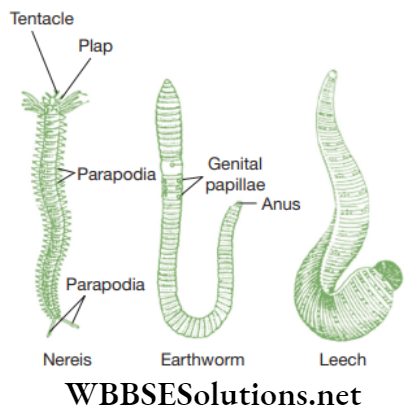
Phylum 7: Arthropoda
- Body is triploblastic, bilaterally symmetrical and metamerically segmented.
- Body segments are grouped into two zones, such as cephalothorax (head and thorax together) and abdomen or three zones, such as head, thorax and abdomen.
- Body consists of distinct head having sense organs and brain at the anterior part.
- A complex muscular system is present with exoskeleton for attachment, striated muscles for rapid actions and smooth muscles for visceral organs.
- No cilia are there.
- Each body segment (‘somite’) generally possesses paired lateral and jointed legs or appendages.
- Body cavity is haemocoel, i.e., filled with blood. The coeloms are reduced to spaces of the genital and excretory organs.
- Alimentary canal is complete; mouth and anus are oppositely placed in the body.
- Respiration takes place through general body surface by gills, air tubes (tracheae) or book-lungs.
- Circulatory system is open with dorsal heart, arteries and haemocoel (blood sinuses). No capillaries and veins.
- True nephridia is absent. Excretion by coelomoducts, Malphighian tubules or green or coxal glands.
- Sexes are generally separate.
- Terrestrial or aquatic (freshwater and marine), free-living, commensal or parasitic forms.
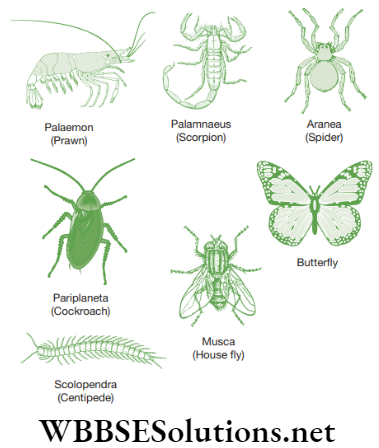
Phylum 8: Mollusca
- Body is soft, bilaterally symmetrical with minor segmentation and without appendages.
- Body is divisible into three parts, such as an anterior head, a ventral muscular foot and a hard dorsal visceral mass.
- Respiration takes place through gills (called ctenidia), mantle or a ‘lung’ of the mantle.
- Simple digestive tract.
- Circulatory system is open except in cephalopods.
- Excretion occurs by a pair of metanephridia or kidneys.
- Sexes are generally separate.
- Sensory organs are present.
- Aquatic forms are mostly marine with few fresh water forms and some are terrestrial.
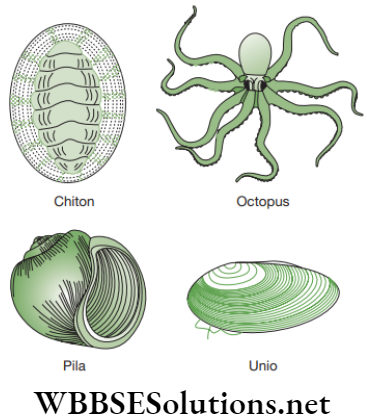
Phylum 9: Echinodermata
- Body is star-shaped, spherical or elongated.
- Body is triploblastic, coelomate, unsegmented and radially symmetrical.
- Body wall is covered with spiny hard calcareous plates called ossicles, which forms a rigid or flexible endoskeleton.
- Body cavity is modified into a unique water vascular system that moves respiratory and locomotory organs, the tube feet or podia.
- A complete digestive system is present. Anus is absent in ophiuroids.
- Reproduction is sexual, asexual or by regeneration. Sexes are separate.
- Only marine animals.

Phylum 10: Hemichordata
- Body is soft, unsegmented, worm-like and bilaterally symmetrical.
- Body consists of three parts, such as proboscis, collar and trunk.
- Pharyngeal gill slits are present.
- Notochord and true dorsal nerve cord is absent.
- Respiratory system consists of gill slits that connect the pharynx with outside.
- Buccal diverticulum is present in proboscis.
- No nephridia. Excretion is performed by single glomerulus, which is connected to blood vessels.
- Only marine animals.
- Mostly tubicolous and detritus feeders such as earthworms.
Example: Balanoglossus (Tongue worm)
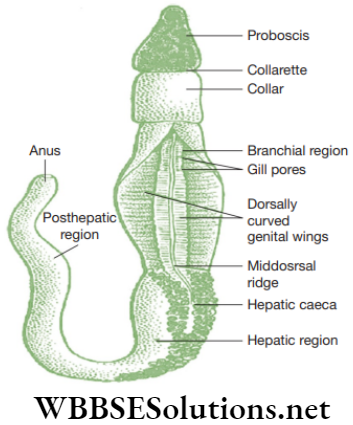
Phylum 11: Chordata
- A dorsal, hollow, tubular nerve cord is present.
- A pliable rod known as notochord is present ventral to nerve cord and is replaced by a bone or cartilage to form a vertebral column in vertebrates.
- Paired gill slits in the pharynx.
- Body is bilaterally symmetrical, triploblastic and coelomate.
- A post-anal tail is present at some stage of life.
- Segmental muscles in an unsegmented trunk.
- Ventral heart with dorsal and ventral blood vessels and closed blood vascular system.
- A complete digestive system is present.
- A cartilaginous endoskeleton is present in vertebrates.
Chapter 3 Diversity In Living Organisms Vertebrata
It includes two subphyla, such as Agnatha and Gnathostomata.
Subphylum 1: Agnatha
- Possess vertebral column and cranium.
- No true jaws but have a sectorial mouth.
- No paired appendages or fins.
Subphylum Agnatha includes only one class:
Subphylum 2: Gnathostomata
- Vertebrates with jaws and paired appendages.
Subphylum Gnathostomata is categorized into six classes.
Class 1: Chondrichthyes
- Marine fish with wholly cartilaginous endoskeleton.
- Streamlined body, either laterally compressed and spindle-shaped or dorsoventrally flattened and disc-shaped.
- Mouth is ventral in position.
- Skin is tough and covered with small placoid scales.
- Respiration occurs through gills.
- Possess fins for swimming and balancing. Fins may be paired (pectoral, pelvic) or median (dorsal, caudal and anal).
- Tail or caudal fin is heterocercal. Muscular tail is used for movement.
- Heart is two-chambered.
- Digestive system has a J-shaped stomach and intestine has spiral valves. Stomach is absent in chimaeras.
- Alimentary canal and urinogenital ducts open into a common aperture known as cloaca.
- Ureotelic animals, i.e., excrete urea.
Example: Scoliodon (Dog-fish, Indian shark), Torpedo (Electric ray), Chimaera (Rat fish).
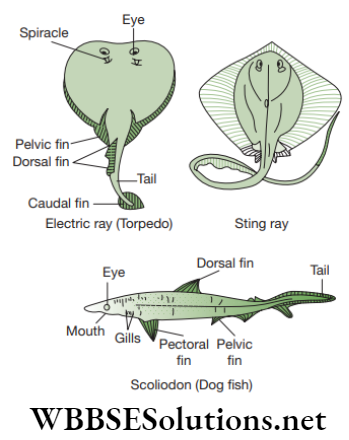
Class 2: Osteichthyes
- Marine as well as freshwater fish with partial or full bony endoskeleton.
- The body is usually spindle-shaped.
- Skin is either naked or covered with cycloid or ctenoid scales.
- The mouth is generally terminal in position.
- Four pairs of filamentous gills are present, which are covered by operculum.
- Tail or caudal fin is homocercal.
- Cloaca is absent. Anus and urinogenital apertures are distinguished.
- Ammonotelic animals, i.e., excrete ammonia.
- The heart is two-chambered consisting of one auricle and one ventricle.
- Ectothermic, i.e., cold-blooded.
- They lay eggs and fertilization is external.
Example: Labeo (Rohu, carp), Hippocampus (Sea horse).
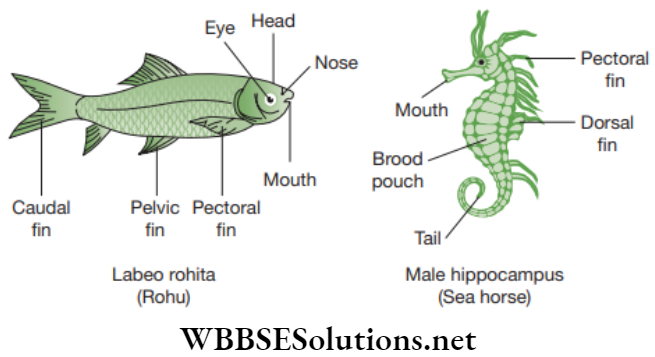
Class 3: Amphibia
- In context of evolution, amphibians form the first group amongst the chordates to live outside water and consist of four-legged (tetrapod) land vertebrates. They live on land but they need water to lay their eggs.
- Live partly in freshwater and partly on land.
- Skin is smooth or rough, moist, slimy, glandular and mostly without scales. Skin has mucus glands.
- Body is divided into head and trunk with no neck. Mouth is generally large.
- Three-chambered heart consists of two auricles and one ventricle. Double circulation takes place through heart.
- Respiration takes place either by gills, lungs, skin or the mouth lining.
- Excrete either ammonia or urea.
- Oviparous, lay yolk-laden eggs with gelatinous covering generally in water. Fertilization is external in frogs and toads but internal in Salamanders and Apoda. Metamorphosis is present.
- Ectothermal.
Example: Rana (Bull frog), Bufo (Toad), Hyla (Tree-frog).
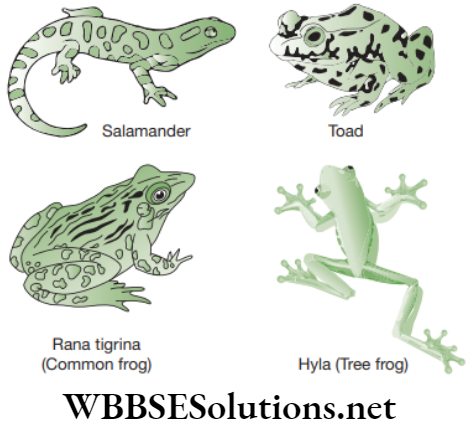
Class 4: Reptilia
- Ectothermic, i.e., cold-blooded, terrestrial or aquatic vertebrates with a body covered with dry waterresistant skin with horny epidermal scales.
- Body is divided into head, neck, trunk and tail.
- Limbs are tetrapodous pentadactyle type with clawed digits. Limbs are absent in snakes and some lizards.
- Tympanum is small and depressed.
- Teeth are present except in tortoises and turtles.
- Respiration is through lungs only. No gills are present.
- Heart is three-chambered and is distinguished into two auricles and an incompletely divided ventricle.
- Terrestrial reptiles like snakes and lizards excrete uric acid.
- Fertilization is internal.
- Most reptiles are oviparous and lay their eggs with tough covering and do not need to lay their eggs in water. A few reptiles are viviparous (for example, lizards and snakes). No aquatic larval stage.
Example: Testudo (Land tortoise), Chelone (Green turtle), Hemidactylus (House wall-lizard), Draco (Flying lizard), Naja (Cobra), Crocodilus (Muggar), Gavialis (Gharial).
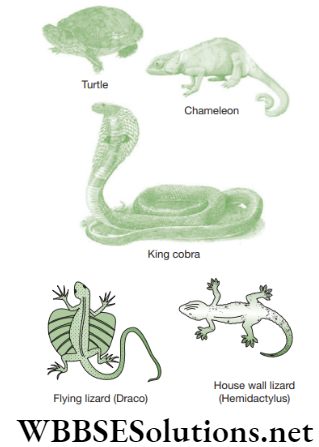
Class 5: Aves
- Warm-blooded, tetrapodous vertebrates (birds).
- Horny scales persist on the feet but feathers cover most of the body. Cutaneous glands are absent.
- Spindle or boat-shaped body is divisible into head, neck, trunk and tail.
- Forelimbs are modified into wings for flight. Kiwis possess vestigial wings.
- Hind-limbs have four clawed digits and are adapted for walking, perching and swimming.
- Narrow jaws make a horny beak. Teeth are absent.
- Bones of endoskeleton are light and spongy owing to the presence of air cavities.
- Breathing takes place through lungs.
- Four-chambered heart consisting of two auricles and two ventricles.
- Cloaca is present.
- Uricotelic animals without bladder.
- Fertilization is internal. They are oviparous and lay large, yolk-laden eggs with hard shell.
Example: Passer (House sparrow), Corvus (Crow), Columba (Pigeon), Psittacula (Parrot).
Class 6: Mammalia
- Warm-blooded (endothermic and homeothermic).
- Body is divided into head, neck, trunk and tail. Eyelids are movable.
- Mammary glands that secrete milk in females are present.
- Fleshy external ear (pinnae) present. Middle ear with three ossicles (malleus, incus and stapes).
- Teeth are thecodont (embedded in sockets in the jaws) and are heterodont (distinguished into incisors, canines, premolars and molars).
- Two pairs of pentadactyl limbs are present. Digits in the forelimbs and hindlimbs are never more than five and end in claws, nails or hoofs.
- A muscular diaphragm separates thoracic and abdominal cavities.
- Respiration happens through lungs only.
- Heart is four-chambered. Enucleated biconcave red blood corpuscles are present.
- Ureotelic animals.
- Fertilization is internal.
- Viviparous, i.e., produce young ones.
- Parental care is highly developed.
- Mammals are primarily terrestrial animals.
Example: Homo (Human being), Macropus (Kangaroo), Oryctolagus (Rabbit), Elephas (Elephant).
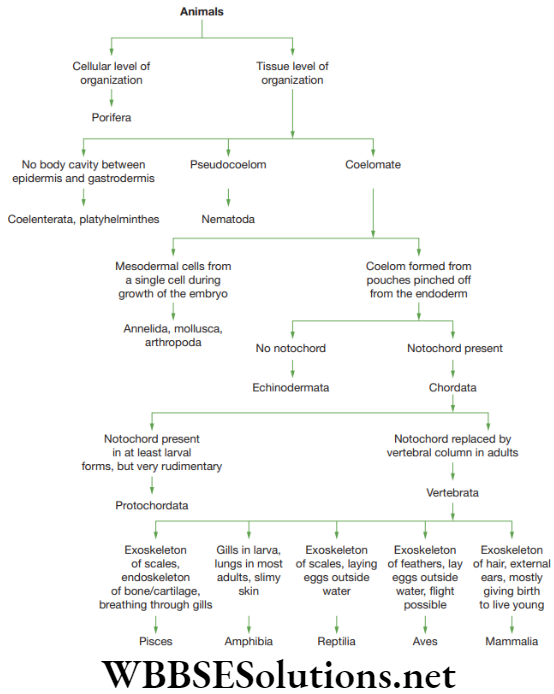
Chapter 3 Diversity In Living Organisms Classroom Corner Fill In The Blanks
Question 1. ______ is popularly known as the ‘Father of Taxonomy’.
Answer. Linnaeus
Question 2. ______ is the study of evidence of past life in the form of fossils.
Answer. Paleontology
Question 3. The method of arranging organisms into groups based on similarities and differences is called ______.
Answer. Classification
Question 4. ______ is a group of individuals with similar morphological characteristics that can breed among themselves and produce fertile offspring of their own kind.
Answer. Species
Question 5. The body of a multicellular and filamentous fungus is termed as a mycelium and it consists of numerous thread-like structures called ______.
Answer. Hyphae
Question 6. Sessile, sedentary, and marine except for one group that lives in freshwater. They are popularly known as ______.
Answer. Sponges
Question 7. Nephridia are osmoregulatory organs that are found in many ______.
Answer. invertebrates
Question 8. Parasitic nematodes are pathogenic. For example, Wuchereria bancrofti causes ______ in humans.
Answer. elephantiasis
Question 9. Most primitive plants, in which plant body is not differentiated into roots, stem,s and leaves. Instead, it is in the form of ______.
Answer. thallus
Question 10. ______ is a group of species that are related and have less characteristics in common as compared to species.
Answer. Genus
Chapter 3 Diversity In Living Organisms True or False
Question 1. Gymnosperms differ from angiosperms in having covered seed.
Answer. False
Question 2. Non-flowering plants are called Cryptogamae.
Answer. True
Question 3. Bryophytes have conducting tissue.
Answer. False
Question 4. Funaria is a moss.
Answer. True
Question 5. Compound leaves are found in many ferns.
Answer. True
Question 6. Seeds contain embryos.
Answer. True
Chapter 3 Diversity In Living Organisms Match the Columns
Question 1.
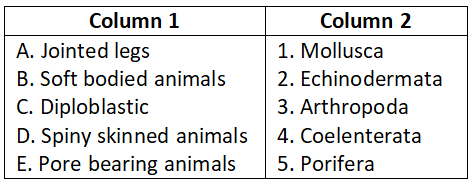
Select the correct option.
- A-4, B-3, C-1, D-5, E-2
- A-2, B-4, C-5, D-1, E-3
- A-3, B-1, C-4, D-2, E-5
- A-4, B-2, C-5, D-3, E-1
Answer. 3. A-3, B-1, C-4, D-2, E-5
Question 2.
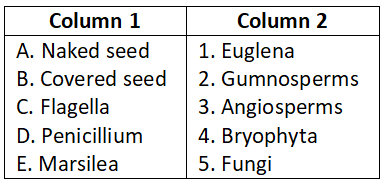
Select the correct option.
- A-4, B-3, C-1, D-5, E-2
- A-2, B-4, C-5, D-1, E-3
- A-3, B-1, C-4, D-2, E-5
- A-2, B-3, C-1, D-5, E-4
Answer. 4. A-2, B-3, C-1, D-5, E-4
Question 3.
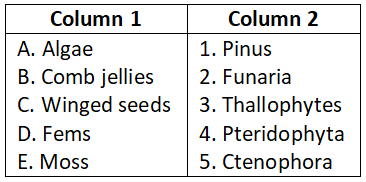
Select the correct option.
- A-4, B-3, C-1, D-5, E-2
- A-2, B-4, C-5, D-1, E-3
- A-3, B-5, C-1, D-4, E-2
- A-2, B-3, C-1, D-5, E-4
Answer. 1. A-4, B-3, C-1, D-5, E-2
Question 4.
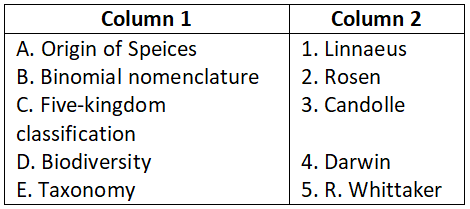
Select the correct option.
- A-4, B-1, C-5, D-2, E-3
- A-2, B-4, C-5, D-1, E-3
- A-3, B-1, C-4, D-2, E-5
- A-2, B-3, C-1, D-5, E-4
Answer. 1. A-4, B-1, C-5, D-2, E-3
Question 5.
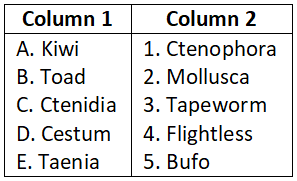
Select the correct option.
- A-4, B-3, C-1, D-5, E-2
- A-2, B-4, C-5, D-1, E-3
- A-4, B-5, C-2, D-1, E-3
- A-2, B-3, C-1, D-5, E-4
Answer. 3. A-4, B-5, C-2, D-1, E-3
